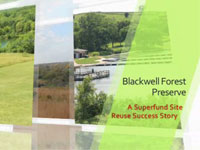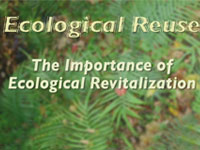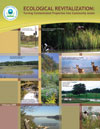
Publications, Resources, and Links
- Home
- EPA Presentations
- Principles for Ecological Land Reuse
- Soil Science
- Soil Amendments
- Terrestrial Carbon Sequestration
- Plants and Revegetation
- Growing Gardens in Urban Soils
- Ecosystem Services
- Creating Pollinator Habitats as Part of an Ecological Revitalization Project
- Act Locally
- Land Revitalization Assistance
- Case Study Profiles
- Publications, Resources, and Links
- EPA Publications
- EPA Websites
- Videos
- Federal Resources
- State Government Resources
- Additional Government Publications
- Additional Resources and Publications
- Glossary of Ecological Land Reuse Terms
EPA Publications
- Barriers, Opportunities, and Strategies for Urban Ecosystem Restoration: Lessons Learned from Restoration Managers in Rhode Island, U.S.A.
Urban ecosystem restoration can be especially difficult to accomplish because of complications like industrial pollutants, population density, infrastructure, and expense; however, the unique opportunities in urban settings can make urban restoration especially rewarding. The success of urban restoration projects — even those focused primarily on ecological targets — depends on incorporating the findings of social research, though that research is relatively rare. This EPA Report attempts to fill that gap by presenting barriers, opportunities, and strategies for restoration projects in urban settings. Building from interviews with restoration managers involved in a suite of aquatic restoration projects in Rhode Island, the report contributes to the learning axis of adaptive management by identifying and synthesizing the lessons learned from managers' work in urban settings.
- Henry's Knob Site Case Study
This case study highlights ecological revitalization outcomes at the Henry's Knob Superfund Alternative Approach site in York County, South Carolina. The native vegetation on site attracts a variety of pollinator species, including bees, wasps, butterflies and birds. Blue Vervain, for example, attracts a variety of bees and birds, including Cardinals, Swamp Sparrows, Field Sparrows, Eucerine Miner Bees, Halictid Bees and the Verbena Bee.
- Land Revitalization Program Tools for Communities. U.S. EPA. February 2016.
This fact sheet highlights some of the tools that have resulted from regional community-based projects undertaken with assistance from the Land Revitalization Program. These useful tools can be adapted for use in other communities.
- Rocky Mountain Arsenal Case Study
This case study highlights the Superfund Redevelopment Program's cleanup and reuse of the Rocky Mountain Arsenal Site in Colorado, a former munitions production site active during World War II. Following the war, weapons production continued and a succession of other private and military facility uses included pesticide and rocket fuel production. In the early 1980s, the primary liquid waste and munitions disposal area was one of the most polluted sites in America. Today, the site has been transformed into a valuable wildlife refuge and community asset.
- Terrestrial Carbon Sequestration: Analysis of Terrestrial Carbon Sequestration at Three Contaminated Sites Remediated and Revitalized with Soil Amendments. EPA 542-R-10-003. Office of Solid Waste and Emergency Response. U.S. EPA. February 2011.
This paper provides EPA's analysis of the data to determine carbon sequestration rates at three diverse sites that differ in geography/location, weather, soil properties, type of contamination, and age. The first site, located at high elevation in Leadville, Colorado, suffered from contamination due to mining. The site was amended with biosolid cakes, biosolids pellets, biosolid compost, and limestone starting in 1998. The second site, located in Stafford County, Virginia, had highly reduced, high-sulfur soils resulting from construction activities for an airport at the site. When exposed to air, these soils rapidly acidified, causing acid runoff that contaminated local streams. The site was amended with biosolids in 2002. The third site, Sharon Steel, is located at the border of Pennsylvania and Ohio and was contaminated through the application of by-products associated with manufacturing steel. At Sharon Steel, soil amendments were applied as part of a field demonstration project in 2008.
- Terrestrial Carbon Sequestration: Field Guide for Sampling and Analysis at Sites Remediated with Soil Amendments. EPA 542-R-10-002. Office of Solid Waste and Emergency Response. U.S. EPA. June 2010.
The U.S. Environmental Protection Agency (EPA)'s Technology Innovation and Field Services division developed this field guide to provide a consistent sampling approach across sites being analyzed for terrestrial carbon sequestration. EPA wants to partner with other federal, state, tribal, and local agencies, academia, and other interested parties to build our knowledge of terrestrial carbon sequestration rates. This field guide focuses on a methodology to provide data that can be used in mathematical equations and models to determine terrestrial carbon sequestration rates in soil. Equations in this guide focus on use of carbon data, but the approach provides for a range of parameters that can be used for related carbon sequestration analyses.
- Ecological Revitalization: Turning Contaminated Properties Into Community Assets. EPA 542-R-08-003. Office of Solid Waste and Emergency Response. U.S. EPA. February 2009.
This document provides technical information to assist property managers and other stakeholders better understand, coordinate, and conduct ecological revitalization at contaminated properties during cleanup. Specifically, this document presents general planning and process considerations for ecological revitalization and provides technical considerations for implementing ecological revitalization of wetlands, streams, and terrestrial ecosystems during cleanup. This document also highlights EPA's initiatives and resources that are available, and presents numerous site-specific examples and case studies where ecological revitalization has occurred.
- The Use of Soil Amendments for Remediation, Revitalization, and Reuse. U.S. EPA. December 2007. (Download 1.74MB PDF)
Hundreds of thousands of acres of disturbed and contaminated land scar this country's landscape. This paper provides information on the use of soil amendments, a cost effective in situ process for remediation, revitalization, and reuse of many types of disturbed and contaminated landscapes.
- EPA CLU-IN Ecological Revitalization Fact Sheets:
- Community Guide to Ecological Revitalization
- Ecological Revitalization Database Fact Sheet
- Ecological Revitalization of Superfund Sites FAQ
- Revegetating Landfills and Waste Containment Areas
- Ecological Revitalization and Attractive Nuisance Issues
- Phytotechnologies for Site Cleanup
- Soil Amendments for Remediation, Revitalization, and Reuse Tools: Fact Sheet (Published 2007)
(Download 2.26MB PDF)
This fact sheet describes two tools developed by U.S. EPA in cooperation with 18 federal and local government, academic, and private sector experts. These tools are designed to encourage and assist site cleanup managers to use soil amendments for remediation, revitalization, and reuse of their sites resulted from this collaboration.
- U.S. EPA. August 2007. Integrating Water and Waste Programs to Restore Watersheds, A Guide for Federal and State Project Managers. EPA 540K07001, Office of Water and Office of Solid Waste and Emergency Response, United States Environmental Protection Agency, Washington, DC.
This manual is intended for Federal and state project managers in water and waste programs who are working on assessment or cleanup projects in watersheds contaminated by hazardous materials or waste.
EPA Websites
- EPA Superfund Redevelopment Program web site
Information on the Superfund Redevelopment Program, including restored sites and their new uses, tools and resources, pilot programs to restore sites, and contact information. - EPA Brownfields and Land Revitalization web site
Basic information on EPA actions and policies surrounding brownfield revitalization, including grants and funding information, tools and resources, and laws and regulations. - Superfund Sites with Green Space Reuse
This website provides links to case studies and information on Superfund sites that are being reused as "green space." Thse sites encompass a wide range of reuse activities including: agricultural reuse (growing crops, pasture land for livestock); ecological reuse (wildlife sanctuaries, nature preserves, wetlands); and recreational reuse (golf courses, ballfields, open space). - Soil Remediation, Revitalization, and Reuse: Technical Performance Measures
The purpose of this website is to provide a tool to assist site project managers in the selection of appropriate technical performance measures (TPMs) for evaluating the remedial success of soil amendments used for remediation, revitalization, and reuse of contaminated sites. - U.S. EPA. 2006. Revegetating Landfills and Waste Containment Areas Fact Sheet. EPA 542-F-06-001
This fact sheet provides information on revegetation of landfill surfaces for EPA site managers, consultants, and others interested in the revegetation of landfill surfaces. - U.S. EPA. ORD EnviroAtlas web site
A collection of interactive tools and resources that allows users to explore the many benefits of ecosystem services.
Videos
Blackwell Forest Preserve: A Reuse Success Story Video

Download MPEG-4 Video (40.9MB)Ecological Reuse: The Importance of Ecological Reuse

Download MPEG-4 Video (21.1MB)Federal Resources
- Bureau of Land Management — National Seed Strategy for Rehabilitation and Restoration
A collaboration between federal agencies, non-federal partners, and valuable input from private industry and tribal, state, and local governments, the National Seed Strategy for Rehabilitation and Restoration is designed to provide a more coordinated approach to restoring plant communities. Its mission is to ensure the availability of genetically appropriate seed to restore viable and productive plant communities and sustainable ecosystems. - National Oceanic and Atmospheric Administration – Office of Response and Restoration
The NOAA Office of Response and Restoration coordinates restoration and recovery efforts for the U.S.'s marine and coastal resources, particularly areas affected by oil spills or marine debris. - U.S. Department of Agriculture:
- Natural Resources Conservation Center Conservation Programs
A list of all conservation programs carried out by the NRCS. Includes programs focused on technical assistance, environmental improvement, stewardship, easement, water resources, and community assistance. - Agricultural Research Service
ARS is the USDA's principal scientific research agency, dedicated to finding solutions to agricultural problems. - Economic Research Service
Describes soil conservation activities carried out by the USDA Economic Research Service, which focuses on costs, benefits, and effectiveness of soil conservation programs. - Forest Service
An overview of Forest Service research and management tools focused on control of non-native plant and insect species and plant diseases. - Forest Service RNGR Team: Reforestation, Nurseries, and Genetics
Technical information, resources, and links for forest and conservation seedling growers. - Grassland, Shrubland, and Desert Ecosystems (GSD) Program
The 2015 Annual Report for the GSD program looks at a few of the 2015 research and application studies conducted by scientists and their partners with GSD. Significant results of recent research and science delivery by GSD scientists are highlighted. - Great Basin Native Plant Selection and Increase Project
A multi-agency collaboration, begun in 2001, to increase the availability of native plant materials and the success of native plant communities in the Great Basin of the United States. - Seedlot Selection Tool
The Seedlot Selection Tool (SST) is a web-based decision-support tool designed to help forest managers match seedlots (seed collections from a known origin) with planting sites based on climatic information. The SST can be used to map current climates, or future climates based on selected climate change scenarios. It can help forest managers or planners match an appropriate planting site with an appropriate seedlot under both current and future climates and to calculate seed transfer distances based on climatic information. The tool allows the user to control many input parameters so the results can reflect the management practices, climate change assumptions, and risk tolerance of the user. - Natural Resources Conservation Service
The NRCS Plant Materials Program selects conservation plants and develops innovative planting technologies to solve the nation's most important resource concerns. Through this page you can find information of the Plant Materials Center nearest you and the resources each center offers. - USDA Service Centers
USDA Service Centers are designed to be a single location where customers can access the services provided by USDA agencies. This web site will provide the address of a USDA Service Center and other Agency offices serving your area along with information on how to contact them.
- U.S. Geological Survey
A directory of all USGS science programs and activities, organized by topic and field.
State Government Resources
For organizations listed by region or individual state please click on the "Act Locally" button located in the menu bar or click here: Act LocallyAdditional Government Publications
- The National Academies of Sciences, Engineering, and Medicine. 2017. Effective Monitoring to Evaluate Ecological Restoration in the Gulf of Mexico. Washington, DC: The National Academies Press.
This report identifies best practices for monitoring and evaluating restoration activities to improve the performance of restoration programs and increase the effectiveness and longevity of restoration projects. It provides general guidance for restoration monitoring, assessment, and synthesis that can be applied to most ecological restoration projects. It also offers specific guidance for a subset of habitats and taxa to be restored in the Gulf including oyster reefs, tidal wetlands, and seagrass habitats, as well as a variety of birds, sea turtles, and marine mammals. - Cullinane Thomas, Catherine; Huber, Christopher; Skrabis, Kristin; and Sidon, Joshua. 2016. Estimating the economic impacts of ecosystem restoration—Methods and case studies: U.S. Geological Survey Open-File Report 2016-1016.
This report provides a detailed description of the methods used to estimate economic impacts of case study projects and also provides suggestions, lessons learned, and trade-offs between potential analysis methods. It estimates the economic impacts of a wide variety of ecosystem restoration projects associated with U.S. Department of the Interior (DOI) lands and programs. The study indicates that ecosystem restoration projects provide meaningful economic contributions to local economies and to broader regional and national economies, and, based on the case studies, we estimate that between 13 and 32 job-years and between 3.4 million in total economic output are contributed to the U.S. economy for every $1 million invested in ecosystem restoration. These results highlight the magnitude and variability in the economic impacts associated with ecosystem restoration projects and demonstrate how investments in ecosystem restoration support jobs and livelihoods, small businesses, and rural economies. - Dumroese, R. Kasten; Luna, Tara; Landis, Thomas D., (Eds.). 2009. Nursery Manual for Native Plants: A Guide for Tribal Nurseries. Agriculture Handbook 730, Volume 1: Nursery Management. Washington, DC: Department of Agriculture, Forest Service.
Available Free of Charge from the U.S. Forest Service.
This 17-chapter manual provides basic, easy-to-understand information for operating a native plant nursery. Intended for use by Native Americans, the manual is well illustrated with photos and line drawings, includes many real-world examples, and would be useful to anyone that is considering starting a native plant nursery, or refining their current operation. - Interstate Technology & Regulatory Council (ITRC). 2006. Planning and Promoting Ecological Reuse of Remediated Sites. ECO-2. Washington, D.C.: Ecological Land Reuse Team, Interstate Technology & Regulatory Council
Promotes ecological land reuse as an integrated part of site remediation strategies and as an alternative to conventional property development or redevelopment. Describes key decision points in a flow diagram format and defines the practicality of applying natural or green technologies to traditional remediation processes. - ITRC (Interstate Technology & Regulatory Council). 2004. Making the Case for Ecological Enhancments. ECO-1. Washington, D.C.: Interstate Technology & Regulatory Council and the Wildlife Habitat Council.
White paper and case studies identify benefits, incentives, and limitations for implementing ecological enhancements at environmentally impacted sites. - University of Texas, Lady Bird Johnson Wildflower Center. Native Plant Information Network
An online database of more than 7,200 native plant species. - Forest Service Nurseries:
The following nurseries are operated by the U.S. Forest Service. They provide seeds, bare root, seedlings, and other vegetation used in ecological restoration projects:
- National Park Service Units:
- Plant Conservation Alliance
A coalition of government agencies and other scientific and conservation groups that is working to solve problems surrounding native plant extinction and habitat restoration. - Federal Native Plant Conservation Committee
A listing and contact information for government agencies, conservation organizations, and academic institutions that make up the Federal Native Plant Conservation Committee. - Estimating the Economic Impacts of Ecosystem Restoration — Methods and Case Studies
This report provides a detailed description of the methods used to estimate economic impacts of case study projects and also provides suggestions, lessons learned, and trade-offs between potential analysis methods.
Additional Resources and Publications
- Center for Invasive Species Management
Comprehensive list of resources for information on restoration and revegetation, including restoration guidelines and management information, sources of native plants and seeds, and links to restoration organizations. - Center for Plant Conservation (CPC) Online Directory
CPC is a network of 36 leading botanic institutions that offers a national program of off-site conservation of rare plant material and maintains the National Collection of Endangered Plants. The online CPC Plant Conservation Directory contains useful contacts in each state for information on rare and endangered plants, permit procedures, and government programs; botanists and other contacts in state Heritage Programs and Native Plant Societies; and a searchable database of organizations and experts active in the conservation of rare plants and their areas of expertise. - Florida Wildflower Foundation - Wildflower Literature
Here you will find a growing collection of scientific articles on Florida's native wildflowers. The wildflowers included are commonly occurring plants that are commercially available or used in restoration projects. - Society for Ecological Restoration International (SER)
SER is an international society for professionals in the field of ecological restoration. The society promotes ecological restoration through conferences, publications, and other activities. - Texas A&M University Revegetation Equipment Catalog
Descriptions and information on equipment used in rangeland restoration and revegetation. - The Conservation Foundation
Not-for-profit preservation, advocacy, and education organization dedicated to protecting ecosystems and the responsible stewardship of the natural world.
- Henry's Knob Site Case Study













